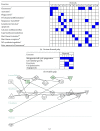Dental Pulp Defence and Repair Mechanisms in Dental Caries
- PMID: 26538821
- PMCID: PMC4619960
- DOI: 10.1155/2015/230251
Dental Pulp Defence and Repair Mechanisms in Dental Caries
Abstract
Dental caries is a chronic infectious disease resulting from the penetration of oral bacteria into the enamel and dentin. Microorganisms subsequently trigger inflammatory responses in the dental pulp. These events can lead to pulp healing if the infection is not too severe following the removal of diseased enamel and dentin tissues and clinical restoration of the tooth. However, chronic inflammation often persists in the pulp despite treatment, inducing permanent loss of normal tissue and reducing innate repair capacities. For complete tooth healing the formation of a reactionary/reparative dentin barrier to distance and protect the pulp from infectious agents and restorative materials is required. Clinical and in vitro experimental data clearly indicate that dentin barrier formation only occurs when pulp inflammation and infection are minimised, thus enabling reestablishment of tissue homeostasis and health. Therefore, promoting the resolution of pulp inflammation may provide a valuable therapeutic opportunity to ensure the sustainability of dental treatments. This paper focusses on key cellular and molecular mechanisms involved in pulp responses to bacteria and in the pulpal transition between caries-induced inflammation and dentinogenic-based repair. We report, using selected examples, different strategies potentially used by odontoblasts and specialized immune cells to combat dentin-invading bacteria in vivo.
Figures



References
-
- Hamilton I. R. Ecological basis for dental caries. In: Kuramitsu H. K., Ellen R. P., editors. Oral Bacterial Ecology: The Molecular Basis. Wymondham, UK: Horizon Scientific Press; 2000. pp. 219–274.
Publication types
MeSH terms
Substances
LinkOut - more resources
Full Text Sources
Other Literature Sources
Medical

